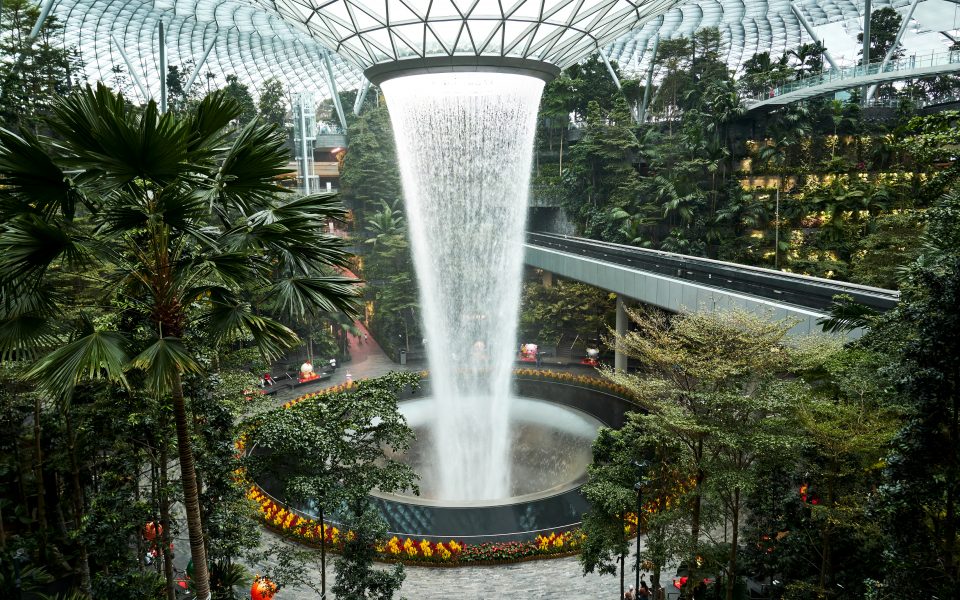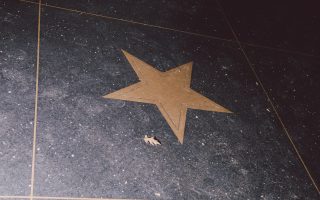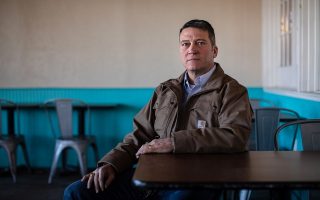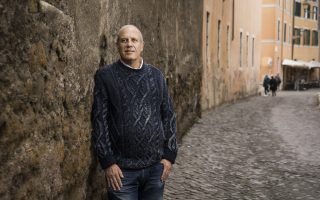A year without travel

On March 11, 2020, the World Health Organization declared that the coronavirus outbreak had reached the level of a pandemic, with “alarming levels of spread and severity.” Almost immediately, international travel ground to a halt, as countries closed their borders, airlines canceled flights, and cities around the world went into lockdown. The losses in life, health and people’s livelihoods continued to mount.
The blow to the travel industry and all who depend on it was stunning: International arrivals at US airports fell by 98% in April 2020 compared with the previous year, and stayed at that level for months. According to the Organization for Economic Co-operation and Development, the global tourism economy is expected to shrink by about 80% when all the data for 2020 is in. With the one-year anniversary of the pandemic upon us, we looked at places around the world that are heavily dependent on tourism to see how they have adapted.
ST. CROIX, US VIRGIN ISLANDS
Horses still have to eat
Jennifer Olah had barely signed the deed to a 2-acre farm, a new home for her equestrian nonprofit on the western end of St. Croix, when Covid-19 hit.
Cruzan Cowgirls began in 2013 to rescue and rehabilitate horses on the island and educate local youth about the animals. Olah relied on volunteers to help care for the horses, and international visitors to pay the bills. Horseback tours along Rainbow Beach and through the island’s rainforest, each tour lasting roughly 1 1/2 hours, would bring in about $100 per rider, excluding tips. Olah gave tours to some 25 people a week.
After a stay-at-home order was issued March 23, 2020, all nonessential businesses on St. Croix were forced to shut down, and cruise ship arrivals stopped. Olah’s base of customers dried up during her busiest season of the year. “We were forced to close in March, but our horses still had to be cared for,” she said of her stable of 25 horses. “We had to figure how to fend for our family.”
St. Croix is one of the three major islands that make up the US Virgin Islands, an archipelago in the Caribbean Sea and a US territory that relies heavily on travel and hospitality to power its economy. Typically, tourism represents 60% of its gross national product, but in 2020, the number of visitors to the US Virgin Islands dropped more than 60% compared with 2019, falling to a little over 800,000 in 2020 (excluding December) from more than 2 million the year before.
In St. Croix, that meant a doubling of island unemployment, an increase in petty theft and the closure of many businesses – some for as long as 10 months. For Cruzan Cowgirls, worries about everything from food to burglaries ensued.
“Buying feed is really expensive here because all of our feed needs to be brought in from off islands,” Olah said. Same goes for vets: With no equine doctors on the island, Olah has to fly one from the mainland when a horse falls ill or needs care. Proper medical attention and food can easily amount to $500 per horse each month.
Because she had no regular employees on payroll, Olah was ineligible for loans through the Paycheck Protection Program. To endure the shutdown period, she held several fundraisers online by explaining her predicament on Facebook and other social media.
“We texted every rider who has ridden with us for the past eight years and asked them to donate or purchase a gift certificate for a tour they could use once the restrictions for Covid lifted,” she said. Their efforts raised enough money to get her through the rough patch in March.
Periodic theft has also left Olah concerned. “All of our horse feed was stolen a few months ago; on another occasion, our generator was stolen, all of our bridles were stolen twice and a couple of saddles and saddle pads,” she said. “Someone even took a few chickens and ducks, and last Friday someone stole three horses.” (The horses have since been found).
To save money, she has cut down on the amount of feed given to her horses, to 16 pounds per week from 18 pounds per week. “With a 10% cut in feed, we could stretch what food we had further.”
At one point she had so many sleepless nights that she developed an ulcer and even set herself up with weekly therapy sessions because she was so overwhelmed.
“I constantly wondered what might happen to all the horses if we didn’t make it through,” Olah said. “It was really scary, and it still is because we don’t know when this will end.”
Despite the challenges, her spirits are up. Olah has started to see a bounce back in tourism. The island is open again, with air arrivals increasing over the past few months. Some popular island restaurants are hard to get into.
“We barely survived until now, and we are still catching up,” she said, but noted that tours have started again, although numbers are still lower than pre-pandemic: 15 riders per week on average, compared with 25 before.
“I think the vaccination has given some people some confidence that they can start moving around,” Olah said. “We’ve had a lot of health professionals visit recently. Yesterday, I gave a tour to four nurses.”
CHARU SURI
CHANGI AIRPORT, SINGAPORE
Waiting for passengers who don’t come
On a recent Thursday morning at Singapore’s Changi Airport, six people tapped away on their laptops, surrounded by plush chairs in the Changi Lounge. On every other chair, a sticker exhorted people to keep it empty, reminding them that “maintaining a distance keeps everyone safe.” Gone were the buffet of refreshments and snacks. Instead, waiters brought croissants and coffee.
Alyss Leow, a 36-year-old human resources executive, works from the lounge every two to three weeks. She paid $200 for a three-month period.
“There are days when I don’t want to work from home, and this is a sweet spot,” said Leow. “It gives you that kind of psychological break that you need.”
Two years ago, Singapore’s Changi Airport was on a roll. It opened a sleek $1.3 billion shopping and entertainment complex with a movie theater and the world’s tallest indoor waterfall. It was voted the world’s best airport for the seventh consecutive year. Over-the-top and instantly iconic, Changi handled a record 63.8 million passengers in 2019.
Then, as Covid-19 spread around the world, passenger traffic at Changi dropped nearly 83% last year. The airport’s net profit fell 36% to roughly $327 million. It suspended construction on a fifth terminal. In January 2020, 33,000 flights took off from Changi. That number dropped to 7,500 the following January.
To cope with the slowdown, the airport decided to focus on its only market: Singapore residents. Even before Covid, many locals flocked to the airport to eat, shop and study. Adapting to the pandemic, airport executives have offered “glamping” and go-karting and converted the Changi Lounge into a coworking space. They invited parents to bring their children for sleepovers and educational tours.
Analysts say these efforts are mostly stopgap measures that could tide the airport over a little until travel comes back, but they would not improve revenues in any meaningful way.
“It’s mainly hibernating until things come back,” said Brendan Sobie, a Singapore-based independent analyst for Sobie Aviation, an aviation consultancy. “For Changi, 2021 will be worse than 2020.”
As an airport that has relied solely on an international market, analysts say, Changi will struggle more than most of its peers in recovering from the pandemic.
The pause has prompted the airport to rethink its role in a post-Covid world. It had always been a destination in itself, but the pandemic gave it a reason to launch a more ambitious experiment: Could the airport draw people to stay longer?
Airport executives started thinking about how travel-starved Singaporeans could experience Jewel, the mega shopping complex, “in a brand-new way,” said Jayson Goh, managing director of Changi’s airport operations management.
Their idea for “Glampcation in the clouds” put 10 tents in an empty airport plaza facing the famous waterfall. But it was skewered by internet users who questioned why people would spend at least $240 a night to sleep on a concrete floor without an en suite bathroom. (There were queen-size beds.)
“It was ridiculous,” said Jason Chua, a lawyer who had walked past the tents. “It’s like they were animals in cages and people were looking at them sleep.”
Even so, the monthlong holiday event sold out within 24 hours, Goh said.
Goh said these activities were “a good experiment” for the airport to see whether Changi, in the eastern part of Singapore, could be an add-on for foreign visitors who decide to stay in the eastern precinct. The airport is close to Changi Village, home to several resorts and hotels that are popular weekend getaways.
One of the airport lounges, the Changi Lounge, was meant to target passengers who had flown in to take cruises. Now, airport officials are promoting it as a “tranquil environment to work.”
Despite these efforts, these measures “are not a great substitute for travelers,” said Nitin Pangarkar, academic director of National University of Singapore’s MBA program. “It’s a little bit of incremental revenue you can generate. I don’t think it will make a huge difference to their results, not in the long term.”
Several of the airport’s other features, geared toward passengers transiting for several hours, cannot be easily transformed in a post-Covid world. It stopped operating its butterfly garden and movie theater because people do not want to “loiter and hang around now,” Goh said.
On a recent Thursday, only a handful of travelers, some decked out in full personal protective equipment, were seen preparing to fly out of the airport. Several bored airport employees tapped on their mobile phones, awaiting passengers who never came.
SUI-LEE WEE
PARIS
‘Having a meal delivered is not life.’
In normal times, the restaurant Aux Lyonnais is a go-to place for the classic Paris business lunch of comfort and conviviality. Close to the Paris Stock Exchange and the offices of Le Figaro newspaper and Agence France-Presse, this bistro in an 1890s building filled up every day with business executives, journalists and government bureaucrats eager for old-fashioned, Lyon-style cooking and loud laughter.
These days, Aux Lyonnais’ blood-red facade looks the same, but inside, it is quiet. The simple iron-framed oak tables are naked without their runners, place settings and balloon wineglasses. Some of the bistro chairs have been put into storage. The zinc bar has been polished. The oversize beveled mirrors, creamy white moldings and green and rose-colored floral tiles have been scrubbed clean, awaiting the moment when restaurants in Paris can open.
And Alain Ducasse, Aux Lyonnais’ owner, looks a bit lost. Over the years, Michelin has showered him with stars; the rich and powerful have flocked to his restaurants in France and around the world. Between 40% and 60% of the clientele at Ducasse’ establishments in Paris – his three-star namesake at the Plaza Athénée, his two-star restaurant in Le Meurice hotel, as well as Aux Lyonnais, Ducasse sur Seine, Rech, Benoit, Allard, Spoon and Cucina – were tourists.
The pandemic upended his world; indeed, the world of cuisine in all of France. Restaurants and cafes throughout the country are shut tight; there is no road map for when they might reopen.
Like many chefs here, Ducasse, 64, has turned to takeout (either for delivery or “click & collect”), but not just any takeout. He turned Aux Lyonnais (temporarily) into “Naturaliste” and transformed the kitchen that once served classics like pike quenelles with crème fraiche-heavy Nantua sauce and calves’ liver with parsley and potatoes into a staging area for what he calls “healthy” fare – no meat, salt, sugar or dairy and heavy on fish, soy, fruits and vegetables.
A starter is 6 to 9 euros (about $7 to $11), a main course 12 to 14, dessert 7. Dozens of boxes filled with meals to be delivered are piled high (100 to 150 every day) along one wall of the restaurant.
“I like extremes,” he said.
Naturaliste’s Marvic Medina Matos, a 25-year-old chef from Peru, and her staff have concocted a menu that includes ceviche with butternut squash, red onion and hummus; beets with smoked eel, cabbage and pine nuts; roasted apple with ginger, a chestnut emulsion and caramel coffee; and a mousse au chocolat with soy milk. The idea is to create entirely new menus that can be prepared in advance.
The day begins at 9 a.m., when Medina Matos arrives with most of her six-member team. Naturaliste’s 11 independent wholesale vendors – including for fish, grains, seasonal fruits, vegetables and eggs – make their deliveries early, either every day or every other day.
The team dons white chef jackets and aprons and divides up the work. One pastry-chef-in-training takes charge of the starters and makes the ceviche. Another young chef oversees the main courses, makes a broth with onions and carrots, chops chard and adds lentils. An apprentice who handles desserts, concocts a crumble with rice flour and a marmalade with lemon and kiwi fruit.
The process goes quickly. Once the order ticket is printed, Medina Matos announces it out loud; the kitchen team answers “Yes!” The dishes are ready in three to four minutes.
All take responsibility for moving the dishes into boxes made of cane sugar pulp; the cutlery, which comes in an envelope with the phrase “Naturaliste” on the front, is made of bamboo. An operations manager bags the boxes and handles the deliveries via a number of services, including resto.paris, supported by the city.
For the moment, takeout is keeping at least a few of Ducasse’s staff employed and perhaps bringing in some money. But dining in Paris is about the food, of course, and it is just as much about “le partage,” the shared experience of celebrating together in a restaurant space.
“When you get six people around a table in France for a good meal, the ritual starts,” said Ducasse. “You open a bottle of Champagne. Then you discuss what you are going to eat. Then you order, and when the food comes, you discuss what you are eating. Afterward, you discuss what you ate. And finally, you talk about what you will eat next week. People want to socialize over a bottle of good wine, to look at beautiful, well-dressed women, not to just sit at the kitchen table looking at their spouses.
“Having a meal delivered to your kitchen is not life.”
ELAINE SCIOLINO
SKAGWAY, ALASKA
A cruise ship town with no cruises
Normally around now, Skagway residents start getting serious about the summer ahead. It’s no joking matter, because if you count the May and September shoulder season, they have to make all their money for the year in five intense months. On a busy summer day, 13,000 passengers disembark from cruise ships to soak up the atmosphere of this Gold Rush-era town in southeast Alaska surrounded by glaciers, mountains, deep fjords and the wilderness of Tongass National Forest.
Despite a year-round population of only a thousand people, before the pandemic Skagway was the 18th most visited cruise ship port in the world, with $160 million flowing annually into its economy. For the summer of 2020, Skagway was expecting 1.3 million tourists to stroll down Broadway, its main street of historic saloons and hotels turned souvenir shops. It’s the kind of tourist-focused town that even Mayor Andrew Cremata has a side gig selling tours at the dock.
Covid transformed Skagway from cruise ship-fueled boomtown to ghost town. There were no cruise ship visits in 2020, and 2021 looks grim as well. To make matters worse, the pandemic didn’t just destroy its economy; it also cut off Skagway’s land connection to the rest of the world. The only road out of town leads to the currently closed Canadian border about 20 miles away.
To avoid a mass exodus of residents, the town came up with a unique idea. Instead of reserving CARES Act stimulus funds for municipal operations – like everywhere else in the United States – Skagway leaders decided to redistribute most of the money to residents. Each full-time resident, regardless of age, received $1,000 monthly from June to December 2020, on one condition: They had to spend the money in town. It could be used to pay a mortgage, to buy groceries at Skagway’s two grocery stores or home improvement supplies at the town’s hardware store, or to patronize the town’s DVD rental store. Receipts proving the purchase was local were required.
To Cremata and other local leaders like Jaime Bricker, president of the Skagway Traditional Council, the rationale was simple: ensure the town’s survival until tourists returned. Other programs they set up included vaccine distribution, coronavirus testing, paying for residents’ medevac insurance as well as helping the town’s food bank and highly rated school. “We had one goal a year ago: make it through to the ’21 season,” the mayor said. “Highly successful. We’re going to make it to the ’21 season.” He paused. “And so, now, we have to make a new goal.”
Cremata was referring to the fact that on February 4, the government of Canada extended a ban on cruise ships in its territorial waters until February 28, 2022. This decision effectively has canceled Skagway’s summer 2021 season.
Town leaders have batted around options. For example, they have proposed a Save Our Skagway campaign, encouraging former seasonal workers to come back and visit. “You can come here and probably have the best vacation of your life without a lot of traffic in town and do all the things you didn’t get to do when you were working 70 hours a week through the summer,” Cremata said.
But no one expects this or any other option being discussed to make up for the usual summer influx of cruise ships. “Businesses have gotten used to the volume that we see from the cruise industry,” Bricker said.
This is certainly the case for Ashley Call and his company, Ocean Raft Alaska. “The more the merrier for my business and, honestly, in Skagway, most of the tour businesses are set up the same way. My doors will stay closed unless I have the volume,” he said, adding that he would be working in construction until the cruise ships returned.
The mayor says circumstances have provoked questioning among residents about tourism and Skagway’s future.
“What’s good for Skagway? Is it healthy to be working 70 hours a week when your kids are out of school or is it healthier to have an economy that is a little bit more sustainable, not only from an economic perspective but from a personal perspective?” Cremata said. “People have said in the past, I won’t even go down Broadway. I won’t even go to the post office when the cruise ships are here.”
Cremata laughed. “There’s always a dichotomy in Skagway. As much as people might complain about going down Broadway, people love tourists here. And I do, too.”
PETER KUJAWINSKI, a Chicago-based writer, is a former US diplomat and the co-author of five books.
HOI AN, VIETNAM
Going back to the sea to survive
Le Van Hung stepped with a mix of angst and hope from his weathered house under coconut palms on Vietnam’s central coast, around the clucking chickens and up the short path to intuit the waves, the sky, the sun.
A calm sea meant that after months of stormy weather he could safely paddle his round basket boat into the South China Sea to catch fish and crab to support his family.
Hung, 51, had been a deep-sea fisherman for many years on bigger boats. But he gave that up in 2019 to help his daughter run the beachside restaurant they opened in 2017 in Hoi An, a historic former port, to ride the city’s surge in international tourism driven by Western adventurers and Asian package tours.
The tourists and most of his family’s income vanished when the coronavirus struck in early 2020, and, in an especially cruel blow, a monsoon dragged their Yang Yang restaurant, perched on a dune, into the sea in November.
Now, like many others in Hoi An who had quit fishing to work in tourism as waiters, security guards or speedboat drivers, or open their own businesses catering to travelers, he has reverted to what he knows best, riding the waves to make a living.
Hung, a short man with a slight paunch and a bad back, supports six relatives who live with him in just a few rooms under a clay-tile roof with wooden shutters. They are barely getting by.
Since September, violent storms and, more recently, strong winds and rough seas, kept Hung off the water, fearful that his hot tub-sized boat would capsize.
Looking at the waves in late February, with half of his restaurant’s brick bathroom still on the littered beach below, he told himself: The day after tomorrow it will be safe.
So at sunrise on a recent Tuesday, Hung stood in his boat paddling up-and-over fizzy 3-foot surf. About 400 yards from shore on undulating aquamarine water, he started unfurling clear fishing net. Trailing from the boat as he paddled, the net created a 6-foot-deep screen eventually stretching more than 500 yards and ready to snare schools of fish.
Hung grew up in Hoi An, which for centuries has been a fishing community wedged between the turquoise sea and emerald rice fields. Its atmospheric ancient town is lined with long wooden Chinese shop houses and mustard-colored French colonials.
Over the last 15 years, Vietnamese developers and international hotels have invested billions of dollars in building waterfront resorts, while locals and outsiders have opened hundreds of small hotels, restaurants and shops in and around the city’s historic core. International tourists flocked to the city, crowding the beaches by day and packing the old town at night. The pandemic hit extra hard because Hoi An had become overly reliant on foreigners. In 2019, 4 million of its 5.35 million visitors were from abroad.
As hotels sprung up around Hung’s home on Tan Thanh Beach, near the old town, the family borrowed from relatives in 2017 to buy a few dozen sun beds and thatch umbrellas and erected an open-air restaurant on the dune behind the house.
His daughter, Hong Van, 23, prepared seafood dishes like shrimp and squid spring rolls. His two sons helped cook and wait tables, and he washed dishes. Hung quit the deep sea fishing crew altogether in the summer of 2019, convinced that tourism was their ticket to a better life.
“I was happier,” Hung, a widower, said through an interpreter. “Working at home is relaxing mentally, comfortable in the daily routine with my family.”
He was pulling in five times the 3 million dong, or about $130, a month he made on the sea.
But the restaurant’s tables emptied as coronavirus crippled Southeast Asia, and Vietnam imposed a nationwide lockdown for most of April.
Then Vietnam suffered its second Covid-19 outbreak in July, 40 minutes north in Danang, just as locals were feeling hopeful about a nascent domestic tourism recovery. That shut everything down again for weeks in Hoi An.
With his savings nearly depleted. Hung knew that he had to return to the sea. By August, he mastered propelling his round boat through the waves with a single paddle. His daughter sold his extra catch on her Facebook page. But the sea became too risky as the rainy season of 2020 pushed into 2021.
On his boat fishing on a calmer sea, Hung put on a plastic smock and gloves and started drawing in the net, spooling it into a pile. He picked out an occasional baby jellyfish, clear like a round ice cube, and after 20 minutes the mesh skirt yielded a 5-inch silver fish and a tiny crab, and then 15 minutes later another small fish.
Because the sea was stingy, Hung paddled back. They’d save a few pennies by grilling the fish, he told himself, instead of frying them and wasting oil. He dreams of abundant catches.
“We hope,” Hung said, “but I never know what happens under the water.”
PATRICK SCOTT, a former business editor for The New York Times, lives in Ho Chi Minh City, Vietnam.
APOLLO BAY, AUSTRALIA
‘Zombie companies’ try to hang on
Before the pandemic, Chinese tourists would stream off big buses into the restaurants in Apollo Bay, a small beach town along Victoria’s 150-mile Great Ocean Road in Australia’s southeast, and a popular stop on a time-constrained day tour down the coast.
They’d fill eateries like the Apollo Surfcoast Chinese Restaurant, a double-fronted, beach-facing diner geared to serve nearly 200 customers at a time wanting a taste of home in a hurry. Now, the restaurant is dark at lunchtime. Large wooden tables and benches, just installed on the sidewalk before the coronavirus hit, are deserted.
Michelle Chen opened the restaurant in 2012 after traveling along the Great Ocean Road and finding nothing for her “Chinese stomach.” With Chinese day-trippers rapidly growing in the region, she saw an unmissable opportunity, which, until last year, was paying off.
China overtook New Zealand as Australia’s largest foreign tourist market in 2017. In the state of Victoria, of which Melbourne is the capital, Chinese visitors spent 3.4 billion Australian dollars ($2.6 billion) in 2019 (more than the next 10 international markets combined) and made up nearly 40% of all international overnight visitor spending. That same year, 45% of Chinese overnight visitors to the state visited the Great Ocean Road region.
This decadelong boom, propelled by China’s growing middle class and proximity to Australia, has driven tourism businesses in Victoria and small communities like Apollo Bay to accommodate by customizing experiences, hiring Chinese-speaking staff and translating menus and national park signage.
But when Australia banned flights from China on Feb. 1, 2020, then barred foreign travel in March, it was like someone had shut off the tap.
“Nearly a hundred percent of my business disappeared,” said Chen. Except for some limited hours around the Christmas period, the restaurant has stayed shut since March.
Farther down the Great Ocean Road, which is flanked by rugged bushland on one side and surf on the other, is the Twelve Apostles, a popular natural attraction of limestone stacks that rise from the water. Here, it’s often “shoulder-to-shoulder” with tourists, especially in peak periods like Chinese New Year, said Sue Ladewig, Parks Victoria’s commercial team leader. “This year I had it all to myself.”
Strict border closures, lockdowns and mandatory quarantine have allowed Australia to suppress Covid-19 extraordinarily well, with 909 total deaths among its population of 25 million. But Australia could stay closed through 2021. And businesses that rely on foreigners may not hang on.
Extragreen Holidays, which offered tours in Mandarin and counted Chinese customers as about half its clientele, could dispatch 16 to 20 buses each week to the Great Ocean Road during peak seasons. “Now we’re lucky if we have one day tour per week, with less than 10 people,” said Tom Huynh, Extragreen’s general manager.
Huynh said the company, which started in Melbourne in 1994, canceled insurance and registration on its 20 or so buses, which have been sitting idle in a depot. Huynh said in late February that the company had gone into liquidation and that staff members were being let go, including him.
At the Apollo Bay Bakery, Sally Cannon, an owner, said she removed the Chinese language signs in the window, which for years advertised the signature scallop pie, after the travel bans came into effect.
“We just thought that’s it, that’ll be it for quite a while,” Cannon said.
Following a snap lockdown in February, tourists – mostly from Victoria – are returning to Apollo Bay, and Cannon’s business has improved.
Max Zaytsev, who runs tours with Bilby Travel, which had mostly Southeast Asian and American clientele, didn’t waste time trying to adapt. Zaytsev has four luxury minibuses that he bought on credit before the pandemic and owes expensive monthly payments on.
In what he described as “a desperate move,” Zaytsev tried switching to courier work – ripping the seats out of one of his minibuses and filling it with delivery packages – but he said he wasn’t earning enough. He tried to diversify again: applying in April for certification to start a disability transport business with his buses, paying about 5,000 Australian dollars (about $3,850) in fees.
“You know how many jobs I got? I got none, zero,” he said. “I was trying to do everything I could.”
Like many Australians with business or employment affected by the pandemic, Zaytsev, who lives in Melbourne, receives a support payment called JobKeeper of 1,000 Australian dollars ($770) from the government every two weeks – but this is set to expire at the end of March.
“It looks like we’re still alive because they’re paying us JobKeeper,” Zaytsev said of tour businesses like his. “We’re zombie companies.”
TACEY RYCHTER






